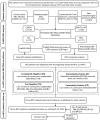The whole-blood Epstein-Barr virus DNA can serve as a valuable molecular marker for diagnosis and prognosis prediction of nasopharyngeal carcinoma
- PMID: 38058812
- PMCID: PMC10695815
The whole-blood Epstein-Barr virus DNA can serve as a valuable molecular marker for diagnosis and prognosis prediction of nasopharyngeal carcinoma
Abstract
The clinical significance and prognostic role of whole-blood EBV-DNA in EBV-associated nasopharyngeal carcinoma (NPC) have not been thoroughly investigated. This study aims to explore the diagnostic and prognostic value of EBV-DNA for NPC in a non-endemic region of China. We enrolled patients with chronic active EBV infection (CAEBV), nasopharyngitis (NA), extranodal NK/T-cell lymphoma, nasal type (ENKTCL-NT), and NPC. Demographic and clinical data were collected and the diagnostic and prognostic values of EBV-DNA were analyzed. Immunohistochemistry was performed to detect EBV-encoded small ribonucleic acids (EBER), as well as the expression of p53, Ki-67, and epidermal growth factor receptor (EGFR). The levels of pretreatment Epstein-Barr virus DNA (preEBV-DNA) in new NPC cases were found to differ from those in other diseases and exhibited varying age distributions. The threshold value of preEBV-DNA for distinguishing NPC from CAEBV and NA was determined. We confirmed that epistaxis, diabetes mellitus, T3N2 or T4N0-2 stage, and IgM positivity were associated with higher levels of preEBV-DNA, and identified risk factors associated with the prognosis of locoregionally advanced NPC (La-NPC). Patients with intermittently or persistently positive EBV-DNA (IPCP), higher preEBV-DNA levels, and positive Epstein-Barr virus-encoded small RNA (EBER) status (EBERpos) had worse survival. New cases of NPC with elevated levels of EBV in the whole-blood and positive EBER status were shown to have a poor prognosis upon progression to La-NPC. EBV-DNA was found to be an indicator for predicting prognosis in La-NPC and could also be used to distinguish new NPC cases.
Keywords: Epstein-Barr virus; NPC; nasopharyngeal carcinoma; whole-blood EBV-DNA.
AJCR Copyright © 2023.
Conflict of interest statement
None.
Figures





References
-
- Chen YP, Chan ATC, Le QT, Blanchard P, Sun Y, Ma J. Nasopharyngeal carcinoma. Lancet. 2019;394:64–80. - PubMed
-
- Sung H, Ferlay J, Siegel RL, Laversanne M, Soerjomataram I, Jemal A, Bray F. Global cancer statistics 2020: GLOBOCAN estimates of incidence and mortality worldwide for 36 cancers in 185 countries. CA Cancer J Clin. 2021;71:209–249. - PubMed
-
- Pan JJ, Ng WT, Zong JF, Chan LL, O’Sullivan B, Lin SJ, Sze HC, Chen YB, Choi HC, Guo QJ, Kan WK, Xiao YP, Wei X, Le QT, Glastonbury CM, Colevas AD, Weber RS, Shah JP, Lee AW. Proposal for the 8th edition of the AJCC/UICC staging system for nasopharyngeal cancer in the era of intensity-modulated radiotherapy. Cancer. 2016;122:546–558. - PMC - PubMed
-
- Hui KF, Chan TF, Yang W, Shen JJ, Lam KP, Kwok H, Sham PC, Tsao SW, Kwong DL, Lung ML, Chiang AKS. High risk Epstein-Barr virus variants characterized by distinct polymorphisms in the EBER locus are strongly associated with nasopharyngeal carcinoma. Int J Cancer. 2019;144:3031–3042. - PubMed
LinkOut - more resources
Full Text Sources
Research Materials
Miscellaneous
